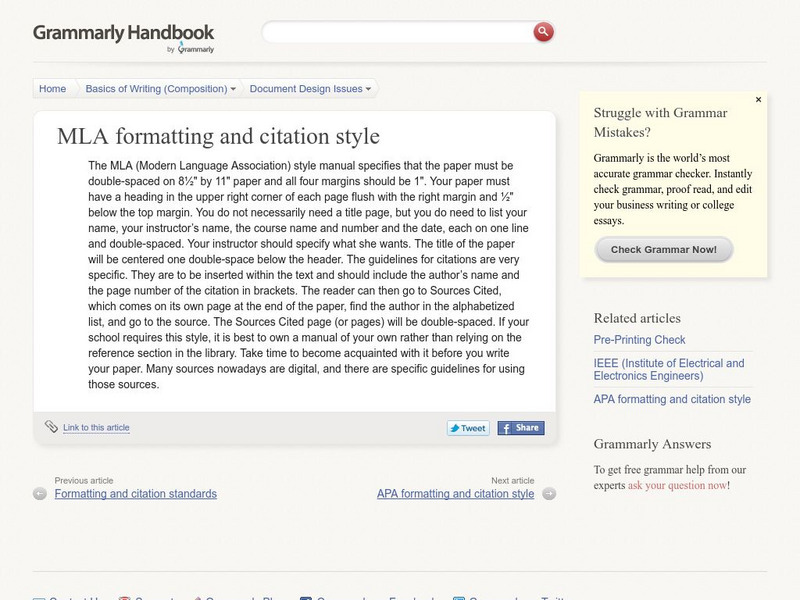Grammarly
Grammarly Handbook: Shifts in Writing
Five areas to edit for shifts in writing: Consistent Point of View, Consistent Verb Tenses, Verbs Consistent in Mood and Voice, Shifts from Indirect to Direct Questions/Quotations, and Shifts from British to American English. Each area...
Grammarly
Grammarly Handbook: Revising and Editing the Draft
Tips for revising and editing a rough draft. Links to additional information on Global Revisions, Editing Sentences, and Proofreading is provided.
Grammarly
Grammarly Handbook: Text Level Measurements of Adequate Writing
This Grammarly Handbook resource provides information about how to check for text-level measurements of adequate writing grammar rules in an essay. This resource will explain the importance of the following: readability, lexical density,...
Grammarly
Grammarly Handbook: Basic Mechanics
This page focuses on the basic mechanics of writing including links to Genre, Thinking, Methods of Reasoning, Evidence, and Citation.
Grammarly
Grammarly Handbook: Organization
A list of the six parts of a thesis paper with links to more information on each.
Grammarly
Grammarly Handbook: Appearance
This page focuses on the appearance of the paper after the writing is complete. It offers links to a pre-printing checklist and a post-printing checklist.
Grammarly
Grammarly Handbook: Research
A list of the six steps of the research process with links to more information on each.
Grammarly
Grammarly Handbook:capitalization:call Letters of Radio and Television Stations
This page explains that call letters for radio and television stations are always in all capital letters and provides examples.
Grammarly
Grammarly Handbook: Italics and Underlining: Foreign Words
An explanation and examples using italics/underlining when writing foreign words in a sentence.
Grammarly
Grammarly Handbook: Negatives
An explanation of a negative sentence and a list of words that show a negative idea.
Grammarly
Grammarly Handbook: Think About Writing Ideas
This Grammarly Handbook resource provides strategies for selecting a writing topic.
Grammarly
Grammarly Handbook: Body of the Text
This page explains how to write the body of the text from your outline (a link to "How to Write an Outline" is provided). The body must support the thesis and provide evidence and examples to support the thesis.
Grammarly
Grammarly Handbook: Headings
This page focuses on the use of headings in a paper. The layout of the headings and subheadings should be determined before beginning the paper to make it easier to read and more attractive. Most important is to be consistent with...
Grammarly
Grammarly Handbook: Formatting and Citation Standards
This page focuses on the formatting and citation standards to use for a formal paper; the three major styles are MLA, APA, and Chicago. Each of these dictates a set of rules to follow for the paper including the formatting of citations...
Grammarly
Grammarly Handbook: Mla Formatting and Citation Style
An explanation formatting the page with MLA Style.
Grammarly
Grammarly Handbook: Chicago/turabian Formatting and Citation Style
This page focuses on the Chicago Manual of Style and its shorter version of Turbian's Manual of Style. It explains the formatting and citation systems and how are similar and different.
Grammarly
Grammarly Handbook: Thesis and Supporting Points
An explanation of a thesis and how many details are needed for support.
Grammarly
Grammarly Handbook: Analysis
This page explains that analysis is crucial to the success of a paper as it answers the questions how and why and shows the reader that the writing is knowledgable. Logic and development work together to make the analysis clear. Examples...
Grammarly
Grammarly Handbook: Cause and Effect
This page explains the cause and effect pattern of organization and provides examples.
Grammarly
Grammarly Handbook: Comparison and Contrast
This Grammarly Handbook resource provides examples of paragraphs that are arranged by the comparison and contrast organizational structure.
Grammarly
Grammarly Handbook: Introduction and Conclusion
Explanations and examples of writing introductions and conclusions.




